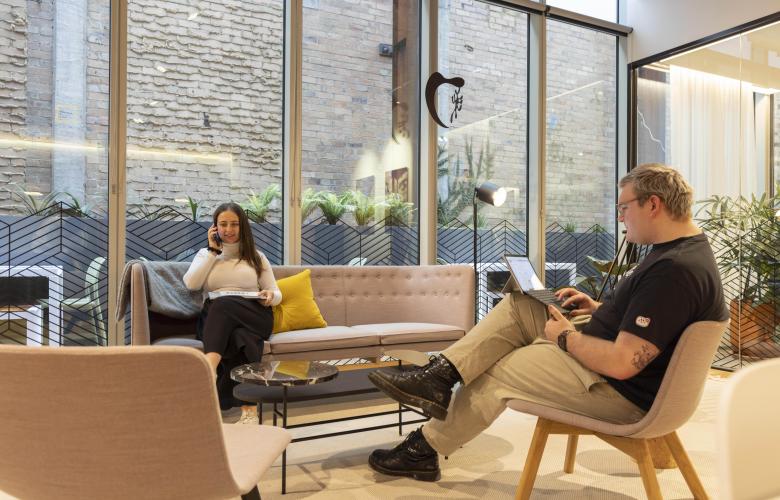Planning to make your space effective for a demand-driven portfolio
Contact
Planning to make your space effective for a demand-driven portfolio
Data clearly shows high and increasing demand for hybrid work among employees. But how can business property stakeholders plan their space more effectively to match their portfolio to the needs of a hybrid workforce?
The national and global workforce share a strong demand for hybrid working. New legislation even grants UK employees the right to request flexible working from day one of their job and business leaders are adjusting their property footprint accordingly. A PwC Remote Work Study shows that 87% of executives expect to make changes to their real estate strategy, including opening more satellite locations and consolidating office space in premier locations.
For landlords and franchise partners, this brings an opportunity to capitalise on a surge in demand. But these opportunities are also available to their competitors. Stakeholders who are able to plan their space effectively to be more conducive to hybrid working will gain a competitive advantage. We look at how commercial property stakeholders can make their space more effective for a demand-driven portfolio.
Design for collaboration
The past few years have resulted in widespread changes to working patterns. The rigidity of nine-to-five has given way to allowing employees the freedom to find their own optimal work patterns.
This means a unique opportunity for landlords and franchise partners to reorganise their properties according to the needs of their business clients.
After Standard Chartered bank signed its landmark deal with IWG, the company’s Head of Talent, Tanuj Kapilashrami explained this employee-inspired approach. “It’s this idea of co-creating the future of work with our colleagues. Currently, 70-80% of our workspaces are not designed around collaborative, task-based work - going forward, colleagues want the majority of workspaces to be designed around this.”
Landlords and franchise partners have an unmissable opportunity to ask their business clients what their employees need to do their jobs more effectively and build an infrastructure around these needs. From robust telecoms infrastructures to 24/7 accessibility, property stakeholders can build their properties around the desired user experience.
Invest in quality
With fewer people in the office at any one time, companies may need fewer square metres, but the quality of that space will be at more of a premium. Since the office is no longer a mandate, it must become a magnet, says Elizabeth Lowrey, principal and director of interior architecture at Boston-based Elkus Manfredi Architects.
No longer a sea of desks, she says, it should be “a genuinely welcoming place where employees want to be – a place of social connection and great tech, where they feel a sense of belonging and can do their best work.”
Invest in quality
Video conferencing has its caveats, but the technology behind it is evolving at an exponential rate in order to make virtual meetings more engaging, immersive and meaningful for participants.
One challenge that landlords and franchise partners will need to face is creating spaces that seamlessly integrate colleagues present at in-person meetings with those joining remotely. ‘Zoom rooms’ – with integrated screens, high-quality sound installations and voice-tracking technology are viable solutions. Soundproof pods may be another option, says Lowrey.
The growing prominence of metaverse technology is also worth considering. A recent white paper by Regus revealed that 65% of business leaders believe the metaverse will transform their operations more than any other video conferencing technology. By providing the flexibility and connectivity that business clients need, property stakeholders can aid business clients in upgrading their videoconferencing.
Combine purpose with pliability
Purposeful spaces are important, but property stakeholders should place much less emphasis on rigid designation and segregation. Multi-functional areas should be the order of the day – for example, an area of individual workstations may be expected to morph into a meeting space when required. Nothing should be fixed, says Lowrey: “Designers must create spaces with flexibility to pivot and adapt to new ways of working – so that when the next crisis happens, it doesn’t feel like a catastrophe, but more like a speed bump.”
Prioritise experience
While some workers remain conscious of hygiene and social distancing in the workspace, others simply want a smooth, high-tech experience throughout their working day. One response to these expectations may be to enable ‘touch-free’ office journeys, where employees use their smartphones to navigate the building. Gesture, voice or facial recognition technology could also be employed to open doors and gain access.
According to research firm Forrester, these are only a few of a raft of measures that have come into consideration among building owners since the Covid pandemic: including contact tracing, temperature measurements, safe zones in lifts, using UV lights to disinfect space, and even Plexiglas barriers between workstations.
Flexible workspace is the fastest-growing sector of the global workplace market. Find out how IWG can help transform your commercial property into a hybrid workspace.
Related Reading:
What a connected office might look like in the future
What do tenants want from the workspace of today?
Why Hybrid Clients Are Thinking Outside The Box
Current Work Trends : What Franchise Operators and Landlords Need To Know
Flexspace Benefits any Business... and any Property | Commo.
Current Work Trends : What Franchise Operators and Landlords Need To Know | Commo.
The Role of Franchise Operators and Landlords in the Future of Flexspace
Suburban rejuvenation. New places for workplaces. New opportunities for landlords.







